Weather refers to atmospheric conditions (e.g., of temperature, humidity, precipitation, wind characteristics, and atmospheric pressure) in a particular region at a specific time. Because weather conditions vary from place to place and time to time, it usually doesn't make sense to talk about "global weather" or weather over very large regions or time intervals.
Climate refers to averages of these atmospheric conditions over a relatively long interval. With climate, the region of interest could be the entire Earth - global climate.
The purpose of this presentation is to outline the fundamental parameters of global climate on a global scale.
Q: Why do weather and climate happen? That is, why doesn't the atmosphere just lie motionless.
A: Because energy is being poured into the climate system. For all practical purposes, the light of the sun and Earth's rotation are the only sources of this energy.
Let's start with something simple
| Terry Pratchett's Discworld series envisions Earth as a disk on the back of four giant elephants who are, in turn supported by the Great A'Tuin, a giant turtle. If the sun were suspended directly above the disc, warming all regions equally, climate would be simple. |

|
| Atmospheric stratification: Even in the Discworld, however, it wouldn't be absolutely straightforward. In terms of atmospheric pressure, the atmosphere grades upward without obvious breaks, but as we've seen, the atmosphere has four distinct zone, each characterized by a distinct thermal gradient: |
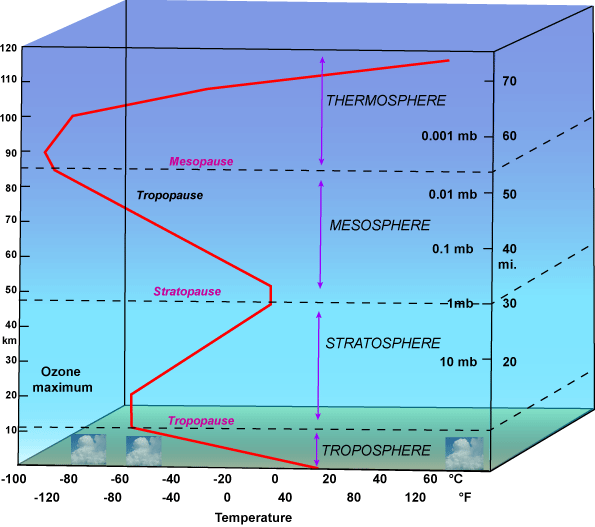
|
The layers:
- Troposphere: The realm of weather
- Stratosphere: The realm of the ozone layer
- Mesosphere: The realm above the ozone layer
- Thermosphere: The fringes of outer space, where Earth's atmosphere encounters the solar wind.
Even in the Discworld, we would see such stratification. But why?


- Is captured by photosynthesizers and transformed into plant tissue.
- Heats whatever opaque bodies absorb it.
- infrared radiation from Earth's surface (which has been directly illuminated by visible sunlight)
- infrared radiation trapped by greenhouse gasses.
- Bulk transport of air through convection.

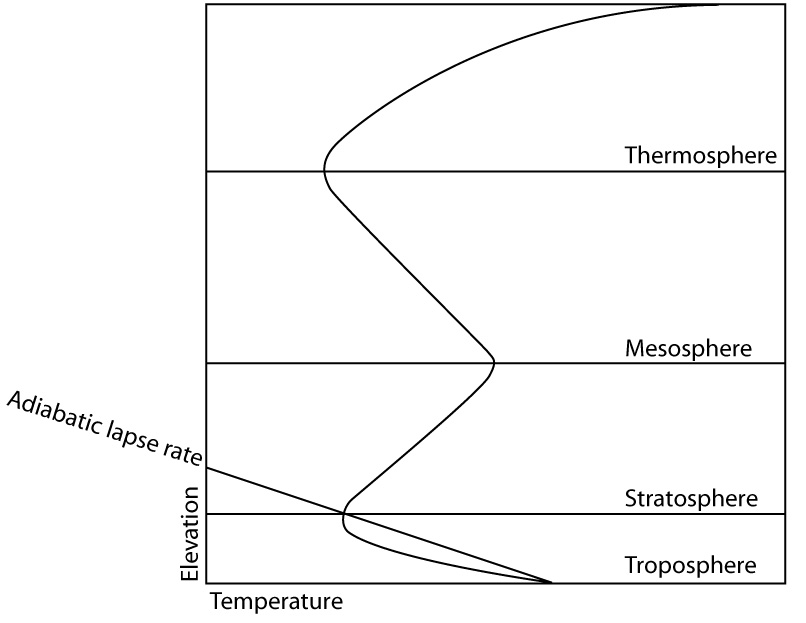 The converse of heat of compression is the cooling that results from decompression. If a location on the planet's surface is particularly warm:
The converse of heat of compression is the cooling that results from decompression. If a location on the planet's surface is particularly warm:
- It emits infrared radiation that warms the air above it.
- This warm parcel of air then rises.
- As it rises into regions of lower atmospheric pressure, it expands to equalize its pressure with that of the air around it.
- As a result of its expansion, the air cools.
Because this cooling occurs even if there is no transfer of heat to surrounding air, it is termed adiabatic cooling. (Adiabatic means "without transfer.") This is the minimum rate at which rising air cools. In practice, there is usually some heat transfer to surrounding air, also.
Adiabatic lapse rate: The rate at which rising air cools adiabatically. As long as the surrounding air cools faster with increasing height than the adiabatic lapse rate, that parcel will continue to rise. Typically, the adiabatic lapse rate is slightly less than general cooling in the lower atmosphere. Once the adiabatic lapse rate exceeds the general rate of cooling, the parcel will no longer rise. This places an upper limit on convection and defines the top of the troposphere.
| Albedo: But there is a small complication: An object's reflectivity is its albedo. High-albedo objects (clouds, glaciers, sea ice, etc.) reflect solar energy back into space as visible light. Low-albedo objects (oceans, forests, etc.) absorb it and reradiate it as heat. Water vapor, the ultimate greenhouse gas, condenses well below the tropopause (the transition from the troposphere to the stratosphere) forming clouds. These reflect sunlight back into space, while the water vapor in and beneath them traps heat from the surface. Thus, clouds amplify the tropospheric gradient. |
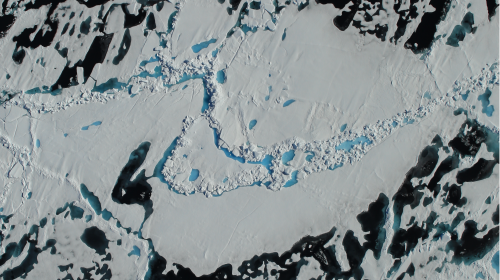
|
Earth's energy budget: Taking all of this into account, we can describe Earth's overall energy budget. On average, solar energy arrives at a rate of 342 watts (i.e. Joules/sec) in the form of visible and ultraviolet light. It's fate:
|
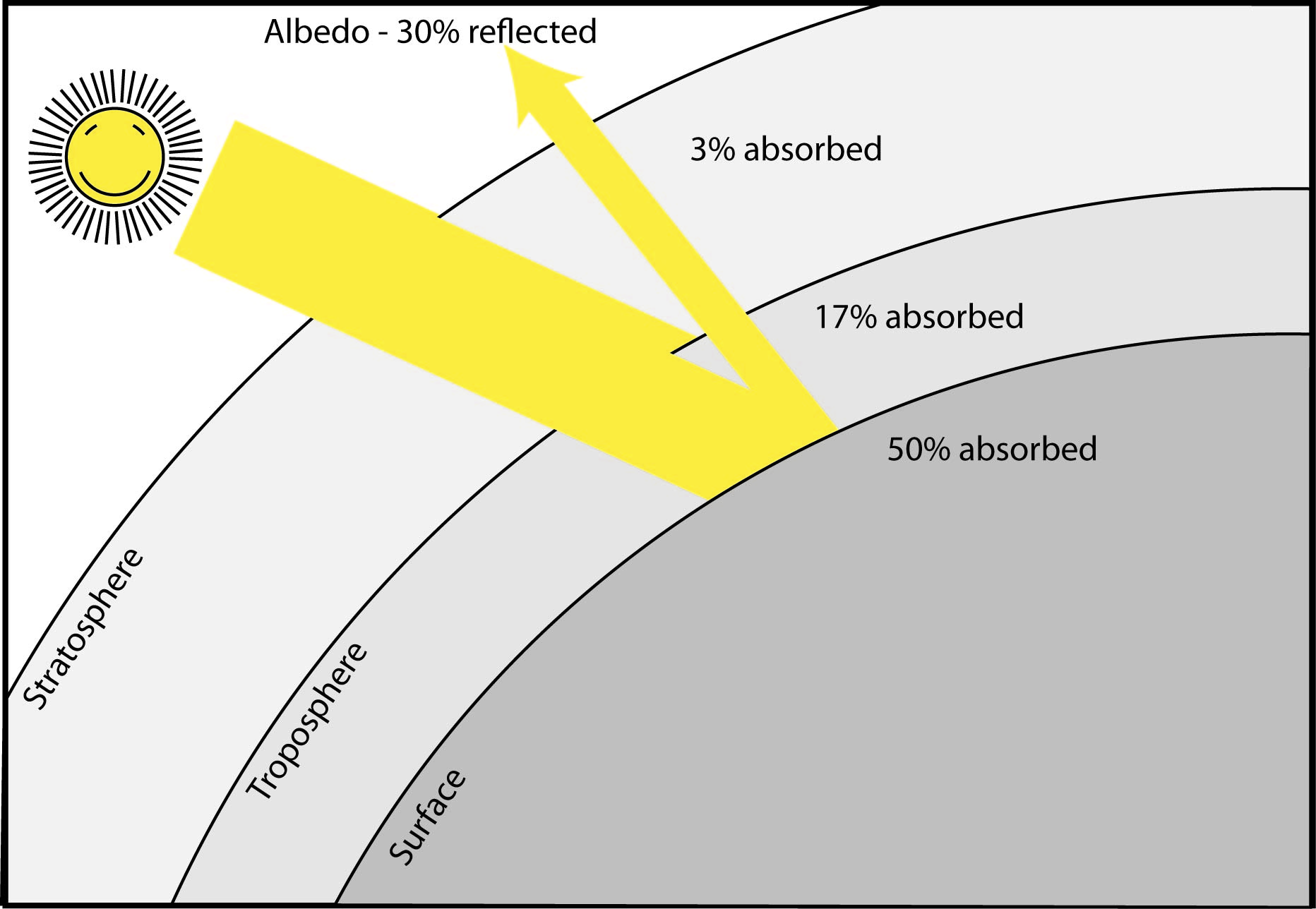
|
| Thermal radiation: But this isn't the end. Absorbed energy gets reradiated at longer infrared (IR) wavelengths. Thus, at any moment, solar energy is passing through the Earth system both as direct solar radiation and as reradiated infrared radiation of energy that had been received from the sun previously. This leads to the paradoxical effect that at any moment, the amount of energy being radiated at infrared wavelengths greatly exceeds the amont being received from the sun. In the graphic at right, the width of the colored line is still scaled to the percentage of incoming radiation at that moment. |
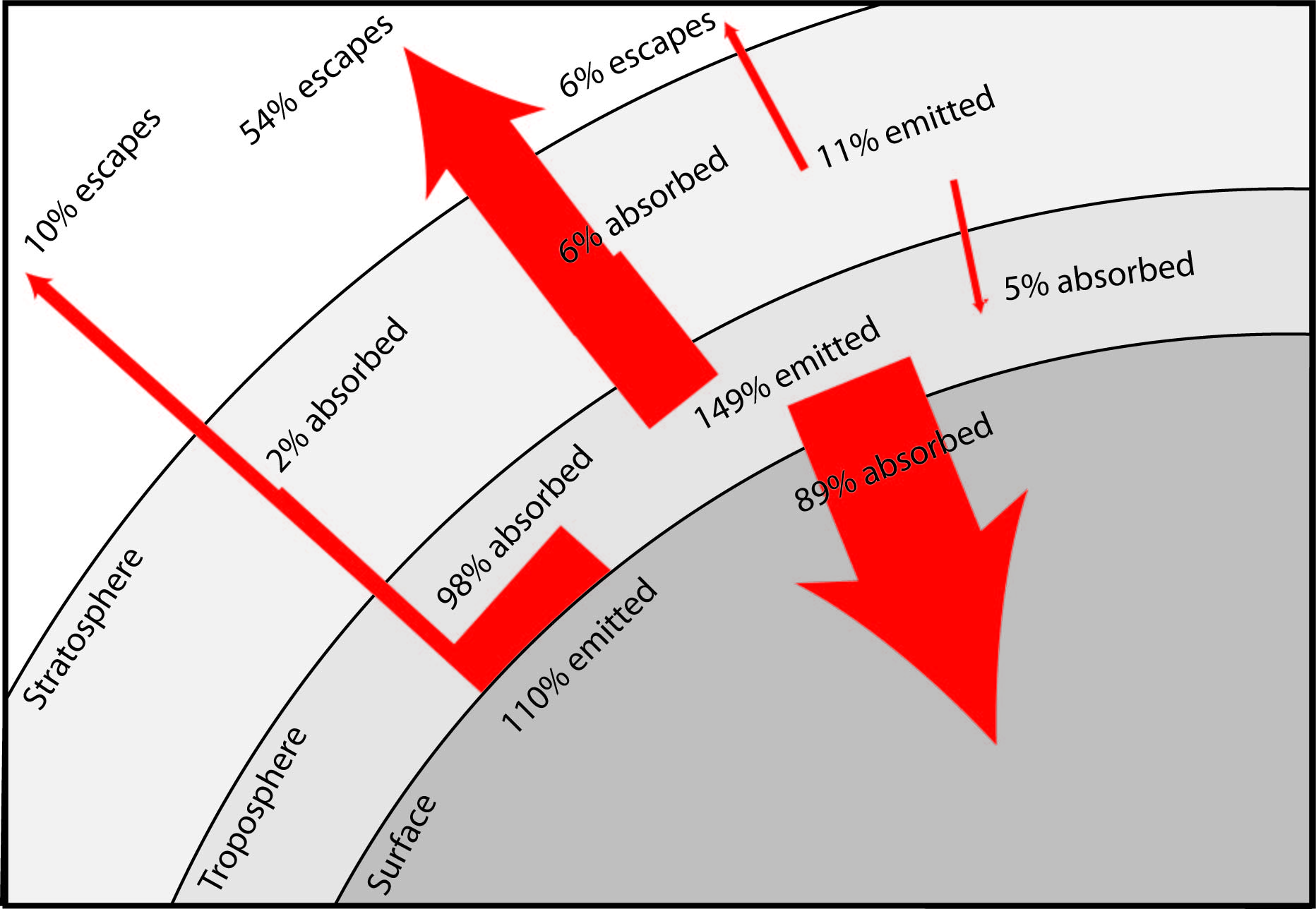
|
|
Inconstant sun: As far as the instrumental record tells, the sun's irradiance doesn't change much. There is an 11 year sunspot cycle in which the sun's energy output fluctuates by 0.15% - a small fluctuation compared to other climate parameters. There is speculation that over the long term, the sun's output has actually varied, however, with climatic consequences for Earth, but the topic is enigmatic.
Note: Don't confuse cycles in solar output with changes in the Milankovich Cycles - Earth's orbital parameters that have forced major long-term climate changes. |
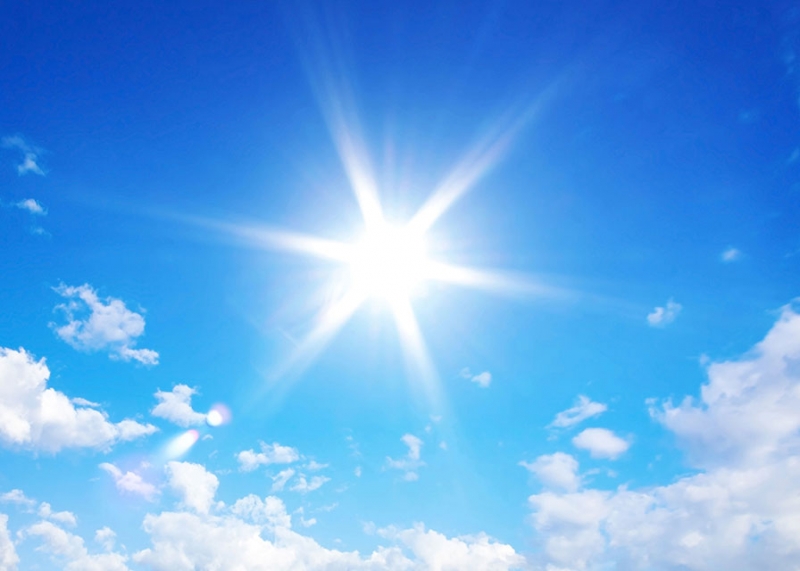
|
Atmospheric circulation: But sunlight does more than heat the atmosphere, it causes it to circulate. Atmospheric circulation is driven by two things:
- The unequal distribution of solar energy
- Earth's rotation.
| Latitudinal differential in incoming sunlight: The amount of solar energy received per unit area of Earth's surface is a function of the angle at which the light strikes. The most concentrated energy is delivered to equatorial regions whereas polar regions receive very little. Resulting circulation is, in part, the atmosphere's attempt to equalize that heat distribution. |

|
| The Coriolis effect: Even if we lived on some Discworld, where solar energy is evenly distributed, that world's rotation would influence the movement of any moving air mass. Conversely, if the Earth didn't rotate, air and water currents would travel in straight lines. The combination of rotation and inertia, however, causes currents to veer onto circular courses. |

|
|
Global convection cells: The interaction of the latitudinal differential and Coriolis force breaks global circulation into three convection cells per hemisphere, forming globe girdling belts:
|
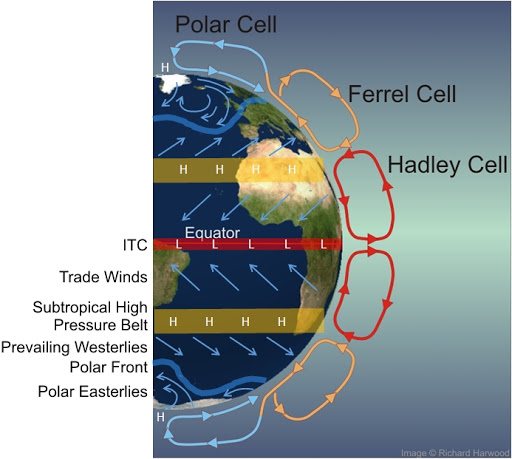
|
| When we translate the schematic above into three dimensions, we see that on Earth's surface we perceive the atmospheric circulation cells as latitudinal wind zones, with easterly trade winds at the bottom of the Hadley cells, westerlies with the Ferrel cells, and polar easterlies at high latitudes. |
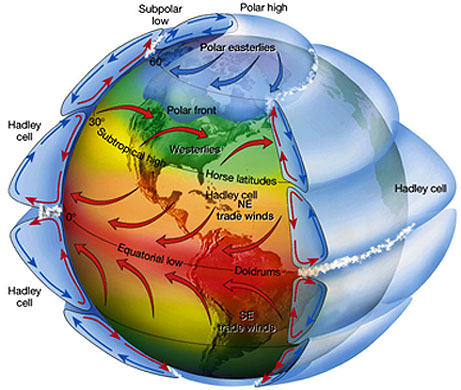
|
What is being moved by these currents?
But note: most of the water vapor in these cells condenses and precipitates out long before it reaches the top of the troposphere. As a result, global atmospheric circulation implies a latitudinal zonation of humidity and aridity. Consider the Hadley cells. Warmer air can hold more water vapor than cool air, so the most humid air is found in the equatorial tropics. As this air rises to form the Hadley cells, it quickly cools and its humidity precipitates out. The result is a belt of rising air with persistent clouds and rainfall, the intertropical convergence zone (ITCZ) (above). By the time the air of the Hadley cells descends to the surface, it is extremely dry. Consequently, land regions near 30 deg. host many of the world's largest deserts: |
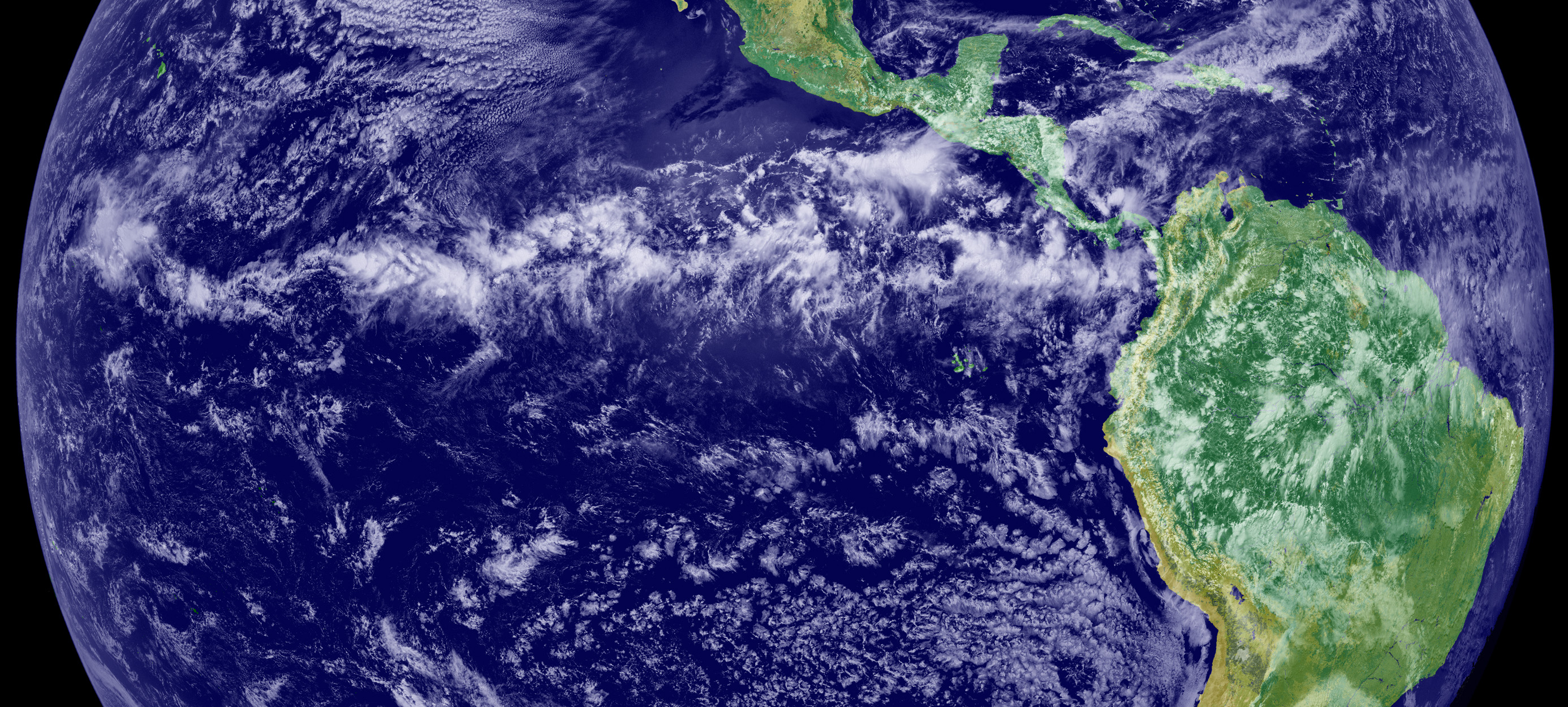
|
At this point, note that we have gone a long way toward describing Earth climate systems using a small number of parameters:
- Insolation
- Atmospheric stratification
- Albedo
- The green house effect
- Global atmospheric circulation
- Presence of oceans and ozone layer
We will put some fine points on this picture next week. For now, lets ask what climate systems would be like if we varied these parameters by looking at other worlds of the Solar System.
 What would Earth's atmosphere look like if there were no oceans?
What would Earth's atmosphere look like if there were no oceans?
In a word, it would look like Venus
They call Venus Earth's "evil twin." Barely smaller than Earth, it's geologic features are similar to what we see here. Because it's size, internal heat, and gravity are similar to Earth's, as are many of its surface features.

Remastered image from Venus' surface by Venera 13.
Effective temperature: The ideal temperature at which a planet precisely re-radiates all of the energy it receives from the sun. Effective temperature is primarily a function of:
- Incoming solar radiation
- The planet's surface area
However, to know incoming solar radiation, we must also consider albedo, the amount of radiation reflected back into space. Clouds and surface features like ice caps have high albedo.
Incorporating albedo into estimates of effective temperature, we get:
- Venus: 227 K
- Earth: 255 K
- Mars: 217 K
- Earth: 288 K
- Venus: 733 K (!)
WTF?
Earth is 33 K warmer than expected. Venus is 500 K warmer. This difference is because of the greenhouse effect
- Venus' average surface temperature is 840 deg F.
- Venus' average atmospheric pressure is 92 atmospheres (What you would experience about 1 km. below the ocean surface). The atmosphere consists mostly of CO2 - a powerful greenhouse gas.
Venus, unlike Earth, has essentially no carbon cycle. On Earth,
- Carbon enters the atmosphere as CO2 that erupts from volcanoes.
- Atmospheric CO2 dissolves in oceans.
- Eventually CO2 precipitates out of solution as carbonate minerals that become incoporated in the rocks.
- As they become buried deeply, they can melt, releasing carbon that, again, is erupted into atmosphere as CO2.
Icing: Did I mention that the clouds are made of droplets of sulfuric acid? (Now breathe deeply.) Follow this link for a fictional but realistic cinematic imagining of Venus' surface. BBC's Voyage to the Planets - Venus.
What if Earth were much smaller with lower gravity and a weaker magnetic field?
Consider Mars.
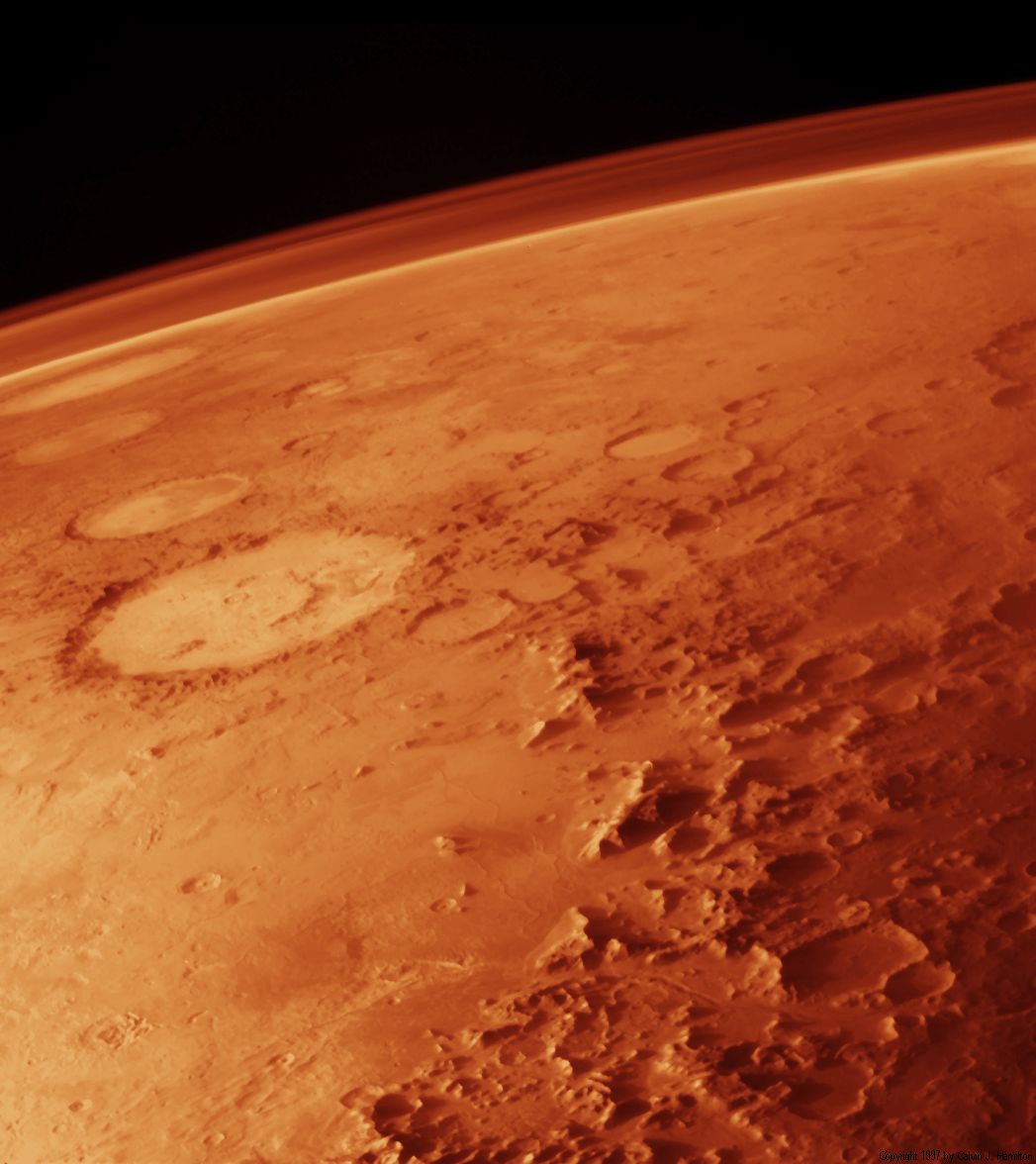 The evidence: Mars has a proper permanent (?) atmosphere. This atmosphere is mostly CO2, but is thin. At 6.3 x 10-3 bars, it is roughly 1/100th the thickness of Earth's.
The evidence: Mars has a proper permanent (?) atmosphere. This atmosphere is mostly CO2, but is thin. At 6.3 x 10-3 bars, it is roughly 1/100th the thickness of Earth's.
- Its butterscotch color mostly comes from tiny dust grains suspended in it. Without this dust, Mars' sky would look black.
- The only time optical scattering of sunlight colors the sky is at sunset, when sunlight passes through enough air to produce blue sunsets.
- Although thin, Mars' atmosphere supports active weather, including global dust storms, and shows seasonal changes.
- At high latitudes, water-ice clouds can be seen.
But now the problem: There is evidence that Mars once had a much more substantial atmosphere. Where has it gone?
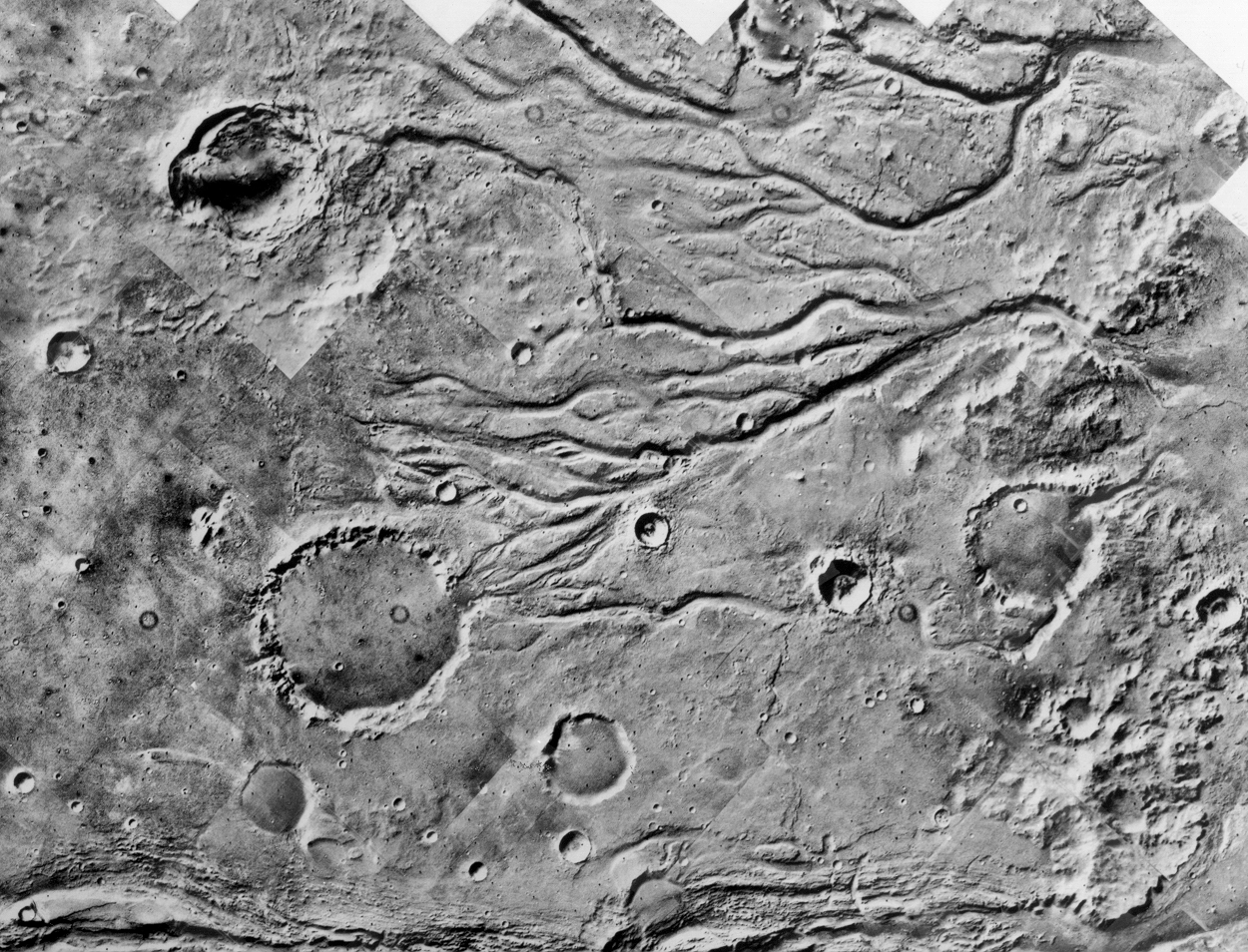
- Features that look like ancient deltas certainly argue for both rivers and larger pooled bodies of water.

So, the water in Mars' atmosphere, at least, seems mostly to have frozen.
But this begs the bigger question: Why did Mars once have rivers and now have, at most, tiny ephemeral flows of groundwater?
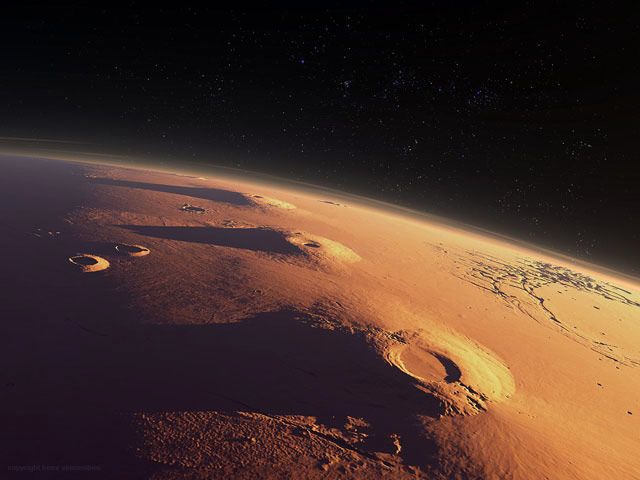
Giant volcanoes Arisa Mons, Pavonis Mons, and Ascraeus Mons
During its first two billion years, Mars was volcanically very active. Even now, it boasts the largest volcanoes in the Solar System. Whether these volcanoes ever so much as burp today is a pressing question, but in all probability, we have missed seeing major volcanic activity there by over half a billion years. So, it looks like Mars' atmosphere is not being replenished.
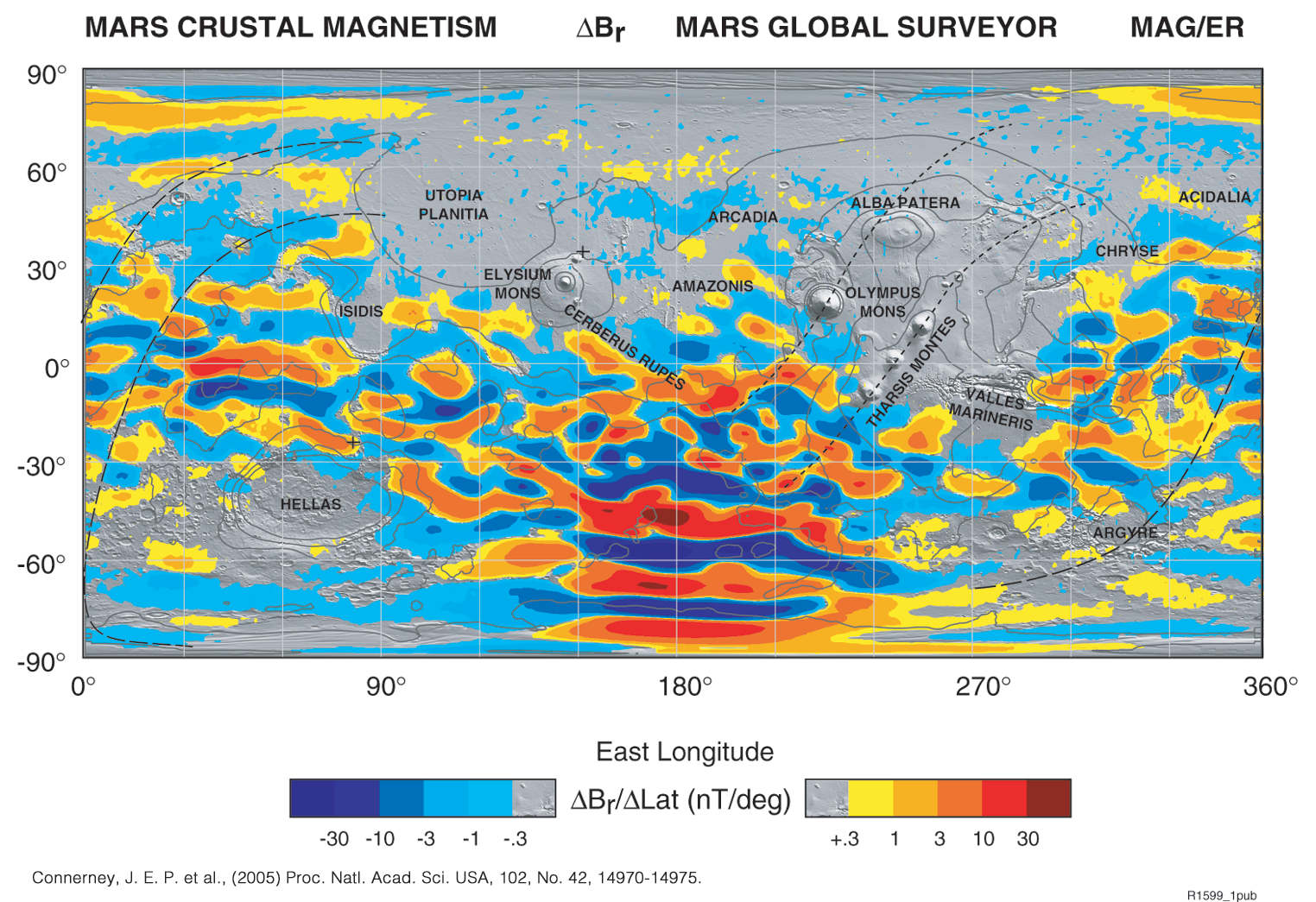 Problem II - Magnetism: But simple leakage is not Mars' only problem. Both Earth and Mars are close enough to the Sun to experience a strong solar wind. On Earth, this wind is deflected by magnetic fields generated by Earth's liquid core. Does Mars have a global magnetic field like Earth's to deflect it? At one time it may have. Recent measurements of weak remnant magnetism preserved in its rocks reveal a pattern of geomagnetic reversals like those of Earth (right). But being smaller, Mars cooled off faster and its core froze. Magnetic patterns are only evident in rocks that are over 2.5 billion years old. Maybe in its early history (the same age as its wet surface) Mars' atmosphere was protected from the solar wind. For most of its history, however, it has not been, so that the solar wind has slowly stripped gasses from its upper reaches. In short, Mars is slowly being undressed by the Sun.
Problem II - Magnetism: But simple leakage is not Mars' only problem. Both Earth and Mars are close enough to the Sun to experience a strong solar wind. On Earth, this wind is deflected by magnetic fields generated by Earth's liquid core. Does Mars have a global magnetic field like Earth's to deflect it? At one time it may have. Recent measurements of weak remnant magnetism preserved in its rocks reveal a pattern of geomagnetic reversals like those of Earth (right). But being smaller, Mars cooled off faster and its core froze. Magnetic patterns are only evident in rocks that are over 2.5 billion years old. Maybe in its early history (the same age as its wet surface) Mars' atmosphere was protected from the solar wind. For most of its history, however, it has not been, so that the solar wind has slowly stripped gasses from its upper reaches. In short, Mars is slowly being undressed by the Sun.
 What if Earth's atmosphere had a really different composition?
What if Earth's atmosphere had a really different composition?
Consider Saturn's cold moon Titan
Physical specs:
- Radius: 2575 km (compared with 1738 for the Moon)
- Density: 1.88 x 103 kg m-3 (compared with 3.34 for the Moon)
- Mostly nitrogen.
- Similar density, being 1.5 x as massive as Earth's.
- A hydrologic cycle based on liquid methane and ethane, including evaporation, rainfall, runoff, and accumulation in liquid bodies the size of the great lakes.
- Vast "seas" of dunes. What are they made of? Some unfamiliar hydrocarbon compound similar in consistency to coffee grounds.
 Titan's idiosyncrasies:
Titan's idiosyncrasies:
- Stratosphere: Titan's photochemical haze blocks visible light by absorbing it at high altitudes and reradiating it as infrared. This makes Titan the only other world in the Solar System with a proper stratosphere.
- Greenhouse effect vs. anti-greenhouse effect: Titan has a greenhouse effect caused by absorption of infrared by cold N2, H2,and CH4 (methane). (At higher temperatures N2 and H2 are transparent to infrared.) Some numbers:
- Titan's effective temperature: 82 K
- Titan's modeled temperature with greenhouse effect: 105 K
- Titan's observed mean surface temperature: 93.7 K
Remember that visible light images of Titan show a featureless orange smog atmosphere. Images showing surface features are in infrared. Thus, infrared wavelengths penetrate Titan's atmosphere and visible ones don't. This results in an anti-greenhouse effect that takes away about half of the heat retained by the greenhouse effect.
Titan paradox: But wait! Titan does not have a magnetic field. Why does it have an atmosphere 1.5 times as dense as Earth's while Mars' is only 0.01? Answers:
- Titan is far enough from the sun that the solar wind is extremely thin.
- Titan orbits inside Saturn's magnetic field.
- But the big reason: Titan is so cold that gas molecules seldom move fast enough to achieve escape velocity. Jupiter's similar-sized moon Ganymede, while cold, at -260 F., is slightly warmer and airless.
All of these are global issues influencing global climate. Earth, however, has geography - a highly varied surface with land and oceans. This fact adds the next layer of complexity to global climate, which we will take up next week.

